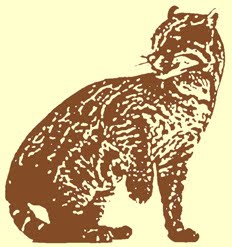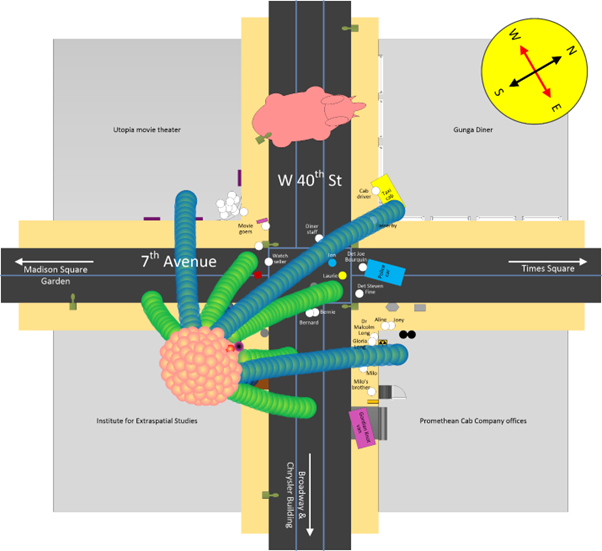One of the things that grabbed me about Watchmen was all those scenes at the intersection of two streets somewhere in New York: the man at the newsstand and the kid next to him leaning against an electric hydrant thing, reading Tales of the Black Freighter; the fabulously named Gunga Diner where Dan and Laurie meet and where Rorschach stakes out his mail drop; the Utopia cinema prophetically showing The Day The Earth Stood Still; the Promethean Cab Company where supporting characters like Joey work, the guy selling watches out of a briefcase just up the street; the nuclear fallout shelter sign on the wall; the freaky 'Hiroshima shadows' image of embracing lovers spray-painted onto a wall; and of course the bland-looking Institute for Extraspatial Studies building, which is fated to be the manifestation locus of Ozymandias' creature.
The last few pages of issue #11 show many of the series' supporting characters converging by chance at that intersection. Aline has come to see her girlfriend Joey and an argument swiftly turns into a violent assault. Gloria Long is quizzing Bernard the news seller about her estranged husband Dr Malcolm Long before spotting him down the street. Detectives Steven Fine and Joe Bourquin are driving by, possibly on their way home. Milo from the cab company and his locksmith brother Ralph are going for a drink after work. The Utopia is packed with moviegoers and just down the street hundreds of knot-topped music lovers are attending a Pale Horse/Krystalnacht concert.
Then there is a bright, white light from inside the Institute for Extraspatial Studies and everybody dies.
Those wide-screen panels at the bottom of the last few pages of issue #11 show the fantastic draughtsmanship of Dave Gibbons, doubtless directed by Alan Moore's characteristically detailed script. We see the lives of these secondary and tertiary characters colliding – literally in some cases – as their personal storylines lead to a climactic resolution. In another book, these people might emerge from this incident more or less in one piece. They would grow and learn from the encounter on that fateful street corner and perhaps end up as better, wiser human beings. But this is Watchmen, and Moore and Gibbons have just killed them all with a giant telepathic squid monster.
The first few pages of issue #12 describe the aftermath of the catastrophic event in graphic splash pages, dialogue-free until Jon and Laurie turn up in the middle of the carnage. We see the bodies, limp and bloody, strewn across the street, hurled against walls. We see vehicles embedded in restaurant windows and heaps of corpses spilling down the steps of the Utopia. We see the monster itself, a bulbous obscenity complete with titanic tentacles and what I can only describe as a bloodshot 'eye-gina' bursting out of the shell of the institute. It's a powerfully cinematic sequence of scenes.
Not only are those splash pages powerful, but taken as a whole they're incredibly precise and consistent; you see a leg in one page and it matches up perfectly with an outstretched body seen from another viewpoint on another page. Just like the entire Watchmen series, it all matches up beautifully like an intricately disassembled clock, waiting for the reader to piece it all together in their mind's eye. Carnage yes, but beautiful in its way.
Somewhere around my second or third rereading of Watchmen back in 1987, I started to get ever so slightly obsessed about those streets, those corners and buildings where it all happened. I wanted, needed, to be able to visualise it as a whole as Moore and Gibbons must have done, to see exactly which building faced which, to work out who worked at which corner, to figure out how close they all were to the monster when it appeared. So I studied the source material for a bit, deduced what went where and drew a little map on some lined paper (see below). I showed the map to my comic-reading wingman Ian and then folded it up inside the Watchmen trade paperback and subsequently forgot about it for 30 years.
My hand-drawn map from 1987
Then Pádraig (Ó Méalóid) invited me to join the editing team for this issue of Journey Planet, and I thought about digging out my old map and maybe redrawing it. Maybe a bit neater on the computer, and labelling things up. And once I'd done a nice map of the streets before the disaster, it shouldn't be too much trouble to use it as a template for a map of the scene after the event.
I may have got a bit carried away.
Have a look at the pictures below, then keep reading to see how I worked out what went where.
W 40th and 7th: Before
Here’s how the intersection looks throughout Watchmen, up to the point that the creature appears.
W 40th and 7th: After
Here’s the intersection as it looks in Watchmen #12. The creature’s tentacles, crashed vehicles and bodies match up to the artwork as best I can manage. Jon and Laurie are indicated by the blue and yellow dots, where they first appear in that issue.
How do we know where this is?
Fortunately, Rorschach's journal tells us that he shadows Dan Dreiberg and Laurie Juspeczyk to the Gunga Diner on 40th and 7th, which gives us the exact midtown location of the intersection, not far from Broadway and Times Square.
The problem with Madison Square Garden
In Watchmen, Madison Square Garden is clearly visible from the intersection (seemingly a block south down 7th Avenue from the Utopia). But in our real world (or Earth N as my co-editor Pádraig calls it in his article) the current fourth Madison Square Garden is further downtown, south and west on 8th Avenue between 31st and 33rd Streets, and therefore could not possibly be visible as seen in (for example) issue #11, page #24.
So in the world of Watchmen (Earth W), the current (as of 1985) Madison Square Garden must have been built in a different location to its real-world counterpart. Perhaps the existence and actions of Dr Manhattan et al caused this curious divergence in municipal planning? Maybe a Moloch or Underboss-run construction racket in the 1960s resulted in a change in the city’s zoning, or maybe the Comedian just shot the architect. We may never know, but there's probably a very niche fanfic in this.
The Comedian's apartment
In Watchmen #1 page 4, Detectives Fine and Bourquin are seen leaving Edward (the Comedian) Blake's apartment building and shortly thereafter walking past a Gunga Diner. Does this mean that the Comedian lived just down W 40 Street from the intersection with 7th Avenue? I don't think so. The diner on page 5 sits in a building with a substantial stone corner which is quite distinct from the Gunga Diner seen in (for example) issue #2 page 4. Gunga Diner is presumably a chain, and the detectives were simply passing a different diner.
Midtown Comics
In the real world, the south-west corner of the intersection is actually the location of the original Midtown Comics, a well-known comics store visited by several of the issue's contributors (other comic stores are available). Coincidence? Probably not.
Attending a signing by Dave Gibbons earlier this year (2023) at London’s Gosh! comic shop, I had a chance to inflict my Watchmen streetmaps on him, which he graciously approved of and confirmed that he used his old building surveyor skills to meticulously plan out the layout of the intersection. As if there was any doubt.
References
As well as Gibbons’ faultless artwork, I drew upon actual streetmaps of Manhattan and the following resources:
The work of AYBGerrardo, who I later discovered had undertaken a similar project to mine. Sadly, the links below no longer work, but I did manage to save a copy of their annotated streetmap.
http://photobucket.com/gallery/user/AllyourbasicGerrardo/media/cGF0aDovd2F0Y2htZW5tYXAuanBn/?ref=




No comments:
Post a Comment